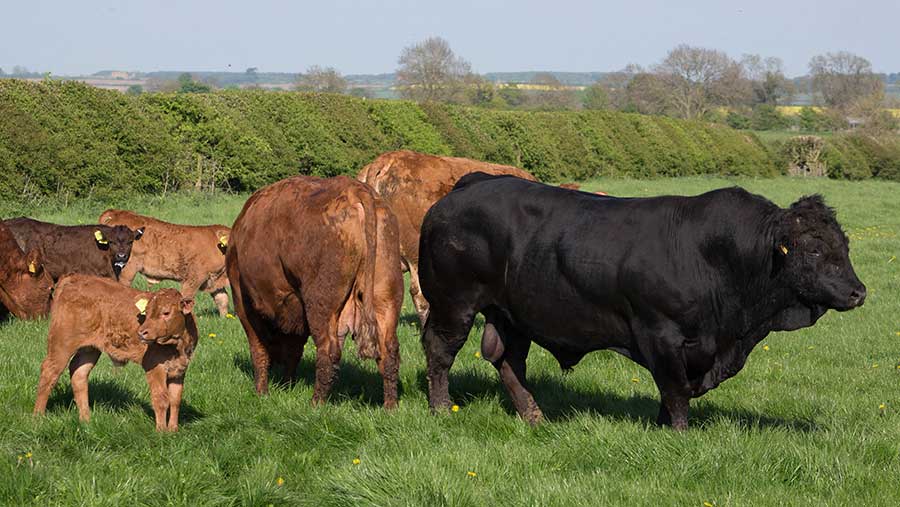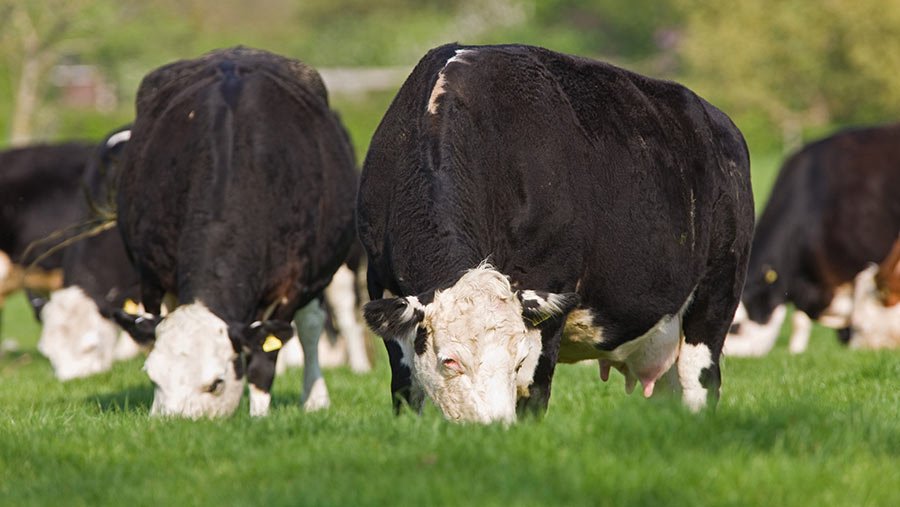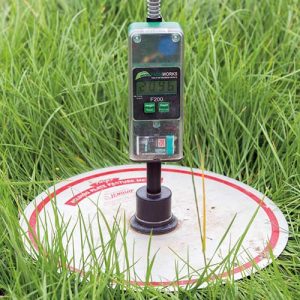Beginner’s guide to rotational grazing beef suckler herds
 © Tim Scrivener
© Tim Scrivener If you already know your rotations from your residuals and your cover from your wedge, then you probably need to read no further. This guide is for beef suckler farmers who want to get more precise with their grazing, but don’t quite know how.
The world of grassland management and different grazing systems can get very technical very quickly, but these steps are aimed to help those in their first year of moving to rotational grazing and trying to get more from grass.
“Ultimately all you are trying to do is match your stocking rate to your grass growth,” says Gareth Davies of Gareth’s Grassland Advisory Service.
“And if you can do that, you should have a reduced need for additional, more expensive, feeds.”
See also: How rotational grazing increased beef daily liveweight gain
There are lots of complicating factors and areas to get more in-depth, but to keep it simple, there are six steps to think about first:
- Each group of cattle will have their own area
- Working on the Guinness and golf ball principle
- Taking a 24-day rotation
- Calculating demand
- Getting measuring
- Closing up
Mr Davies shared his top tips on getting going:
Each group of cattle will have their own area

© Tim Scrivener
Planning a rotation (route) for your stock will depend on various factors – how many cows you have and their size, influencing demand, how many bulling groups you run and your farm type.
If you have a farm with smaller fields, they might work as paddocks, or if your grass fields are larger, they may need breaking up with fencing.
When running several bulling groups, each group would have their own allocated area and their own set of paddocks, which they will rotate around. Unless grass growth circumstances require it, you would not move the groups from one set of paddocks to another.
The difficult thing in the first year is that you won’t have shut up fields or paddocks in a set order as would happen in a rotational grazing system.
This means that you won’t have the staggered growth across paddocks that rotational grazers would typically see before turnout.
Therefore, in year one, you need to have an area/field where you can hold cattle for a time (approximately one week to 10 days) to let grass growth pick up in the first paddock/field you plan to turn them into.
This might mean you need to supplement them for a short time, while holding them back from entering the grass system, while grass ‘cover’ builds.
Grass cover is measured in amount of dry matter available per hectare (DM/ha) and the target should be for that cover to sit between 2,500 and 3,000 when cows enter the paddock.
This can be measured with a plate metre or sward stick, but for simplicity, can also be talked about in terms of the height of the grass.
Working on the Guinness and golf ball principle
A grass cover of 3,000 DM/ha would be roughly the height of a Guinness can (15cm) and 2,500 DM/ha would be roughly the height of a Coke can (12cm).
This is where you want grass to be before cows and calves enter the paddock.
Equally important is the amount of grass left behind, which is called the residual. In cover terms, this should be around 1,500 DM/ha, which is 4cm in height and roughly the height of a golf ball.
At this height, the grass will recover well and have time to grow to the third leaf stage before it is grazed again.
If it isn’t grazed hard enough, you will get ‘stemmy material’ accumulating at the base of the plant, which leads to a decrease in quality.
Taking a 24-day rotation
The rotation length is the number of days it would take for the mob of cattle to go through all their allocated paddocks.
This number can vary depending on geographical area and farm type – on farms where grass growth is very strong, or in peak growth season, this may need to be shorter.
Alternatively, if in an area where grass grows more slowly, a slightly longer rotation might be necessary.
However, 24 days is a good starting point because in many areas any longer than that and quality would start to deteriorate. And it can work with various different numbers of paddocks:
- If you have six paddocks, each one will be grazed for four days
- If you have eight paddocks, each one will be grazed for three days
- And if you have 12 paddocks, each one will be grazed for two days.
Four days is the maximum grazing duration wanted because of the all-important rest period in between grazing.
On a system with six paddocks grazed for four days, the first paddock would have 20 days’ rest for the grass to grow before it is grazed again.
With more paddocks, each paddock would get a longer rest period.
To work out the size of the total area you need and the size of individual paddocks, you need to be able to work out the demand of the livestock.
Calculating demand
Demand will vary through a season as cows progress through gestation and calves mature. So, to optimise demand calculations, this should be redone regularly to account for changes in the herd weight.
However, a very rough figure can be worked out using 3% of combined cow and mature calf weight.
Working out demand with a bulling group of 40 600kg cows with 100kg calves at foot (amend numbers as suitable for individual farms):
1. Work out cow demand
Demand of one cow – 3% of bodyweight (600kg) = 18kg DM/day
Multiply that by 40 = 720kg DM/day
2. Work out calf demand
Demand of one calf – 3% of bodyweight (100kg) = 3kg DM/day
Multiply that by 40 = 120kg DM/day
As the calf grows throughout the season, this number will change.
3. Work out combined demand
Combined demand = 720 + 120 = 840kg DM/day
4. Work out available cover per hectare
This is the opening cover minus the target residual cover. Working on the Guinness and golf ball principle, this is 3,000 – 1,500 = 1,500 kg DM/ha
If your grass will not grow to Guinness can height, you can adjust the opening cover number to get an idea for your farm.
5. Work out total available cover per paddock
This is the available cover per hectare multiplied by the paddock size.
So if you had six paddocks and each paddock size was 2.25ha (5.6 acres), the total available cover per paddock would be (1,500gm DM/ha x 2.25) 3,375kg DM.
6. Calculate how long they can graze that paddock for
Available cover per paddock divided by demand – 3,375/840 = 4.0. This paddock will hold the mob for four days.
The numbers for this come from Step 5 and Step 3.
If this number comes up above four, then the paddock size is too big and will need to be adjusted because they should only graze one area for 4 days maximum to allow recovery between grazings.
Based on these numbers, a total area of 13.5 hectares (33.4 acres) would be required for six paddocks. These six paddocks could each be split in half to create a rotation of 12 paddocks, each grazed for two days.
Note: These calculations use the figure of 3% of bodyweight as a demand calculation. More specific demand percentages can be used and are available from AHDB or independent advisors.
Throughout the season there will be fluctuations in grass growth and the system needs to adapt to that.
If grass growth is poor and covers are not building quick enough, some supplementation with forage or concentrate may be required or extra paddocks need to be introduced to extend the length of the rotation.
Conversely, if grass growth is rapid then it may mean taking paddocks out for one rotation or more.
For example, on a six-paddock system, if grass is growing rapidly and by the time you are grazing paddock number four, paddock one is back at optimum cover (Guinness can), then leave paddocks five and six and restart the rotation at paddock 1.
Paddocks five and six can then be grazed with other stock on the farm, such as sheep or store cattle, or cut for silage.
Getting measuring

Measuring with a plate meter © Tim Scrivener
Knowing how quick grass is growing can give confidence to close paddocks for silaging and help to refine rotation plans in future years.
When you know how much grass your farm grows, you can more-closely match the overall stocking rate to it.
There is lots of grass measuring equipment available – our buyer’s guide explains some of the options.
But the simplest version is a free sward stick from AHDB.
Grass should ideally be measured weekly or more in peak growth, but the key is to measure each paddock at least once between grazings so that there is always a record of how that paddock/field compares to others.
This will help identify any areas for reseeding (see panel).
Closing up
This is key for anyone giving rotational grazing a try this year, to make it easier to get covers the following season. A plan is key so that the first paddocks/fields shut can be the first grazed.
Many dairy farmers using this method would begin closing areas at the beginning of October, so that they were ready to ‘reopen’ in mid-February.
Other things to consider:
Reseeding
Firstly, Mr Davies would never advise reseeding a field without soil sampling it and checking it for compaction first.
And he says reseeding is not a job for year one because until you have assessed the balance between grass growth and stocking rate, it is pointless. There is little use in growing more grass if you are already understocked.
Mr Davies says his preference is to reseed in spring because the peak growth at this time affords the loss of fields/paddocks taken out for reseeding.
And it may be possible to plant a poorer paddock with a crop like turnips or kale for the winter and then reseed in spring, maximising the use of the area.
If reseeding is required, it can provide a very good return on investment. However, if the potential causes of poor paddock performance (eg. compaction) have not been fully investigated then return on investment could be severely reduced.
If a ley is not too old, overseeding might be a suitable option to rejuvenate it.
Seed varieties
Mr Davies’ tips on selecting seeds include:
- Only ever pick off the recommended list. They are recommended for a reason
- For grazing, go for intermediate or late-heading perennials. Only go for early for silage ground
- Keep heading dates as close together as possible
- The heavier the soil, the higher the rate of diploid should be used. Diploid gives a greater ground cover
- Always, without fail, put clover in – white clover for grazing and red clover for silage
- Go for a small- or medium-leafed white clover for persistence.
Infrastructure
Water is the number one excuse for not going into rotational grazing because people think it is expensive to set up, but it can be done with a plastic trough and alkathene pipe.
For the grazing season, it is unlikely in most parts to reach freezing temperatures, so the pipe can run above ground and be connected with push-fit attachments.
Flow rate is more important than trough size, to ensure the trough is full the majority of the time.
Creep feeding
Creep feeding should first be assessed on whether it makes sense, financially, to the business because if stocking rate and grass growth match then additional feed should rarely be required.
If it does make sense, then creep feed should be analysed for the percentage dry matter, so that the demand of calves can be adjusted.
If a calf requires 2.65kg of dry matter a day and it is given 1kg of dry matter in creep feed, then its grass demand falls to 1.65kg of DM/day.
